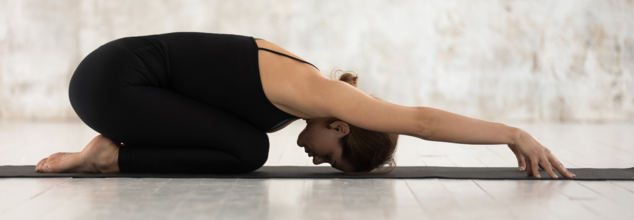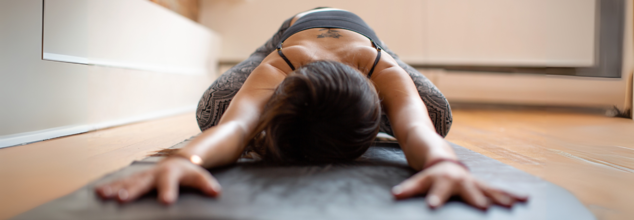- Health Conditions A-Z
- Health & Wellness
- Nutrition
- Fitness
- Health News
- Ayurveda
- Videos
- Medicine A-Z
- Parenting
- Web Stories
These Yoga Asanas Could Cure Your Migraine

Credits: Canva
Yoga can be helpful to maintain physical fitness, but it can also calm your mind and bring peace to you. Yoga has other health benefits too, including helping with anxiety, depression and pain. Yoga is also effective in dealing with stressful events and can relieve you from migraine.
What Is Migraine?
These are headaches, but more intense than the common headaches. They are characterised as throbbing pain on one side of the head and can be accompanied by nausea, dizziness, and sensitivity to light and sound. It can last anywhere between a few hours to a few days.
A 2014 study published in the International Journal of Yoga titled Effect of Yoga on migraine: A comprehensive study using clinical profile and cardiac autonomic functions found that headache frequency and intensity reduced for those who practiced yoga regularly.
Which Poses Can Help?
Child's Pose
- Kneel on the floor and keep your toes together, spread your knees as wide as you can.
- Lower your buttocks on your heels.
- Sit up straight and adjust to this position.
- After you inhale, lean forward so that you head and chest rest between or on top of your thighs. Rest your forehead on the floor.
- Keep your arms extended, palms facing down.
- Hold for a minute and allow your neck and shoulder to release the tension.
This pose can calm the nervous system and reduce pain.
Bridge Pose
- Lie on your back on the floor, with your knees bent and your feet on the floor.
- Extend your arms, palms flat on the floor.
- Now, lift your pelvis upward, following your torso. Your shoulders and head must remain on the floor.
- Make sure your thighs are parallel to your feet. Your weight must be distributed evenly.
- Hold this for a minute.
This pose opens the chest, heart, and shoulders and can reduce anxiety.
Downward Facing Dog
- Start on your hands and knees and align your waist under your shoulder and knees under your hips.
- Stretch out your elbows, relax your upper back and spread out your fingers and press down. Your weight must be evenly distributed between your hands.
- Lift your knees off the floor and straighten your legs.
- Lift your pelvis and lengthen the spine.
- Hold this for two minutes.
This can increase circulation to the brain.
Corpse Pose
- Lie on the floor with your back to the ground.
- Let your legs spread slightly apart, move your arms to your sides and your palm must face the ceiling.
- Hold this position for between 5 to 30 minutes.
This can restore your body to a state of rest.
Yoga & Weight Loss - How To Burn Calories With Yoga?

(Credit-Canva)
Many people think of yoga as just gentle stretching and meditation, not a serious workout for burning calories. But the truth might surprise you! While yoga certainly brings mental calm, it's also a powerful way to engage your body.
Yoga is a fantastic blend of strength, flexibility, balance, and endurance. Experts estimate that an hour of yoga can burn anywhere from 180 to 600 calories. This wide range depends on the style; intense types like Bikram or power yoga will burn more than a gentle, restorative class. To maximize calorie, burn, choosing specific poses is key.
Yoga For Weight Loss
Harvard Health suggests that yoga can help you manage stress, lift your mood, reduce emotional eating, and build a supportive community. All these benefits can be incredibly helpful for both losing weight and keeping it off.
Beyond these mind-body benefits, yoga can also help you burn calories and build stronger, more toned muscles. It might even reduce joint pain, making it easier for you to be more active every day. These are just a few of the many ways yoga can support your health journey.
Plank
This pose is a calorie-burning powerhouse because it forces all your muscles to work against gravity. To burn even more, try lifting one foot slightly off the mat. The longer you hold it – from 30 seconds to five minutes – the more calories you'll melt away.
Chair Pose
Chair pose gets your body's largest muscles, the glutes, working hard, which automatically burns lots of calories. It's a safe and effective move for everyone, regardless of their yoga experience.
Chaturanga (Low Push-Up)
Chaturanga is like holding the bottom of a push-up. When done correctly, it engages most of your major muscle groups. Your core, legs, and arms all work to maintain a perfect 90-degree bend in your elbows. It's a challenging pose that requires focus and control, even for advanced yogis.
Wheel Pose
Wheel pose is an advanced backbend that opens your chest and stretches the entire front of your body. It deeply engages your legs, glutes, shoulders, arms, and even your heart and lungs. You can boost your heart rate even more by doing this pose in a heated room after a good warm-up.
High Lunge
You've probably seen High Lunge in other workouts because it's a full-body move, especially effective for your glutes and quads. This pose also builds strength and requires balance. Any time you add balance to a pose, your body has to work harder, leading to more calories burned.
Sun Salutations
Sun Salutations are a sequence of 12 flowing poses that get your heart pumping. They engage your abs, glutes, calves, shoulders, biceps, and triceps. This series combines breath with movement, energizing, strengthening, and stretching your muscles, while also boosting blood oxygen and strengthening your lungs.
Dolphin Pose
Dolphin pose is similar to downward dog but with your forearms on the mat. It's fantastic because it both strengthens your arms, core, and legs, while also stretching your shoulders and chest. Having your forearms down fully engages your triceps too, making it a powerful pose for overall body engagement.
Forget Ozempic! Woman With A Rare Condition Reveals How This One Daily Exercise Helped Her Lose 140 Pounds In 2 Years

Credits: Hannah Mai/Daily Mail (SWNS)
Dominated by buzzworthy injections like Ozempic and Mounjaro, one woman’s extraordinary story is flipping the narrative. Meet Hannah Mai, a 37-year-old from Coventry, UK, who defied medical odds, overcame a rare hormonal condition, and shed 140 pounds naturally—all without relying on weight-loss drugs.
Diagnosed with Cushing’s disease, a condition marked by dangerously high cortisol levels, Hannah’s weight loss journey wasn’t just about slimming down, it was her battle to reclaim her body con, her identity, and her well-being. Her secret? Daily Pilates, relentless determination, and a clean, protein-rich diet.
For Hannah, sudden and uncontrollable weight gain started around age 30. Despite maintaining a healthy lifestyle and weighing about nine stone (126 pounds) for most of her adult life, she began gaining weight rapidly—seven stone (nearly 100 pounds) in just a few months.
“It was terrifying,” Hannah recalls. “I hadn’t changed my diet. People asked if I was pregnant. I knew something was wrong, but no one believed me.”
Doctors initially dismissed her concerns, chalking up her symptoms to hormones or lifestyle. But the weight kept piling on, eventually reaching 20st 5lbs (285 pounds). More than two years later, her body delivered an unmistakable warning sign—a sudden hunch in her back.
This prompted her to do her own research, where she found a possible explanation: Cushing’s disease, a rare condition caused by excess cortisol. Armed with her findings, she returned to her doctor, this time with a printed list of symptoms in hand.
Cushing’s disease, which affects fewer than 10 people per million each year, is often caused by a non-cancerous tumour on the pituitary gland. This tumour leads to the excessive production of adrenocorticotrophic hormone (ACTH), which in turn signals the adrenal glands to release too much cortisol.
Cortisol, the body’s main stress hormone, affects nearly every system, regulating blood sugar, metabolism, and inflammation but too much of it wreaks havoc, resulting in weight gain (particularly around the trunk and face), thinning skin, mood changes, and high blood pressure.
Hannah’s case was textbook. In October 2020, she was finally diagnosed through MRI scans and blood tests at University Hospital Coventry & Warwickshire. A few months later, in February 2021, she underwent brain surgery to remove the tumour, followed by two years of steroid therapy to help her body rebalance.
By 2023, Hannah’s health had stabilized enough for her to discontinue the steroids. That’s when she decided it was time to take back control of her body.
But rather than jumping on the Ozempic bandwagon, she took a different route a holistic, lifestyle-based approach that focused on daily Pilates, clean eating, and discipline.
“I think Ozempic is great for people who need it medically,” she said. “But I wanted to prove to myself that I could do this. And once I started seeing results, I just kept going.”
Why Pilates Is Beneficial For Gaining Gentle Strength?
For Hannah, the cornerstone of her recovery wasn’t running marathons or punishing herself with extreme workouts. It was Pilates—a low-impact, mind-body exercise that emphasizes strength, flexibility, and alignment.
Done daily, Pilates became her physical therapy, mental reset, and weight-loss weapon.
“Pilates helped me reconnect with my body in a way I hadn’t felt in years. It didn’t stress my joints or overwhelm me,” she explained. “It was something I could do every day—and it worked.”
Combined with a high-protein, low-carb diet tailored for her body’s needs (and free from sugar, dairy, and gluten due to a celiac diagnosis), the results were astonishing: a drop from size 26 to size 10, and a weight loss of 140 pounds over two years.
Hannah’s journey isn’t just about the number on the scale. It’s about resilience, self-advocacy, and trusting your intuition especially when the medical system doesn’t listen.
“When I look at old photos, I feel sad about how far things got. But it also reminds me of how far I’ve come,” she reflected. “I’m proud of myself. And I want others to know it’s possible.”
In a world obsessed with fast fixes and injectables, Hannah’s story is a powerful reminder that transformations come in many forms. Her message is one of patience, persistence, and purpose the kind of inspiration that can’t be bottled in a prescription pen.
Why Is Cushing’s Disease Often Misdiagnosed?
Cushing’s disease is often underdiagnosed, especially in women, whose weight gain is often dismissed as lifestyle-related or hormonal fluctuation. As awareness grows, thanks to celebrities like Amy Schumer, who recently revealed her own Cushing’s diagnosis more people are starting to recognize the symptoms and seek help.
“I knew for years something was wrong with me,” Hannah said. “But I had to fight to be heard.”
Her journey underscores the importance of self-education, advocacy, and second opinions, especially when it comes to mysterious or unexplained symptoms.
As the popularity of weight-loss injections like Ozempic and Mounjaro skyrockets, Hannah’s story offers a refreshing counterpoint. Yes, medications have their place but not every weight-loss story begins or ends with a shot.
Heart Surgeon Says THESE Are The Best Exercises For Your Long-Term Heart Health

(Credit-Canva)
Our heart health is the core of our well-being, lack of exercise, proper food intake and other bad lifestyle habits often put a lot of strain on our hearts. While doctors do emphasize that exercising above all else, many people wonder which exercise is the best to improve their heart health.
To answer this, top US surgeon Dr. Jeremy London, a board-certified cardiovascular surgeon posted a video on Instagram, underlining what exercise he thinks will help our heart the best. He says that aerobic exercise is the best kind of workout for your heart. This type of exercise makes your heart and blood system work better, which helps prevent heart problems. We can measure how well your heart works using something called VO2 max.
What is Aerobic Exercise?
Aerobic exercise is any physical activity that gets your big muscles moving in a steady, repeated way. You can choose how hard your body works during these exercises. Doctors use these exercises to also measure how well you are doing with a VO2 max
The word "aerobic" means "with oxygen." When you do aerobic exercise, your breathing helps get oxygen to your muscles. This oxygen helps your body burn energy and keep moving. There are many different types of aerobic exercises. Some common ones include:
Walking or jogging
Walking is one of the easiest aerobic exercises to start with. You can walk at a pace that feels right for you. Jogging is faster than walking but slower than running. It puts more stress on your joints, so it's not a good idea if you have an injury. All you really need are good shoes. You can walk almost anywhere – outside, in a mall, or on a treadmill – which makes it easy to do all year round. Walking is a great way to begin an exercise routine.
Cycling
You can cycle on a stationary bike or a regular bicycle. You can make it harder by choosing a higher setting on a stationary bike or by riding on hills. Cycling is a good choice if you have joint problems like arthritis, because it's easy on your back, hips, knees, and ankles. If you cycle outdoors, though, bad weather might stop you.
Using cardio machines
Cardio equipment refers to machines that get your heart rate up with repeated movements. Some popular ones are rowing machines, stair climbers, ellipticals, and treadmills. You'll find these at gyms, or you can buy one for your home. Since there are many kinds, it's a good idea to try them out at a gym first. This way, you can see which machine you like best and which one feels good on your body if you have any old injuries or issues. Your doctor can also suggest the best cardio machine for you.
Swimming
Swimming is a gentle activity where you use your arms and legs to move through water. Swimming in open water (like a lake) is usually more intense than in a pool. If you have joint pain, water aerobics or water walking are good alternatives because the water helps support your body, taking stress off your joints. If you're swimming or doing water activities, always make sure there's a lifeguard nearby in case of an emergency.
What is VO2 Max?
Think of VO2 max as a score that tells you how fit you are. Harvard Health explains that a higher score means you're in better shape. It also means you're less likely to get heart disease and may live longer.
When you breathe, your lungs take in oxygen. Your blood then carries this oxygen to your muscles. Your muscles need oxygen to create energy for you to move. The more oxygen you can use, the more energy your muscles have, and the better your workouts will be.
Focus on Your Weakest Link
Dr. London believes that the most important change you can make for your health is to figure out what you're not good at and work on that. He shared that even though he tries hard with his diet and exercise, his biggest challenge is sleep. “We all can do better in various places, but where can I really make meaningful shifts? Well, it's where I'm the weakest, not where necessarily I'm the strongest. And that is where the opportunity exists.”
© 2024 Bennett, Coleman & Company Limited

